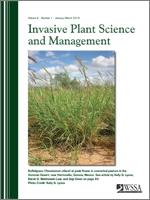Downy brome (cheatgrass) is a highly successful, exotic, winter annual invader in semi-arid western North America, forming near-monocultures across many landscapes. A frequent but poorly understood phenomenon in these heavily invaded areas is periodic ‘die-off’ or complete stand failure. The fungal pathogen Pyrenophora semeniperda is abundant in cheatgrass seed banks and causes high mortality. To determine whether this pathogen could be responsible for stand failure, we quantified late spring seed banks in die-off areas and adjacent cheatgrass stands at nine sites. Seed bank analysis showed that this pathogen was not a die-off causal agent at those sites. We determined that seed bank sampling and litter data could be used to estimate time since die-off. Seed bank patterns in our recent die-offs indicated that the die-off causal agent does not significantly impact seeds in the persistent seed bank.
Nomenclature: Downy brome, Bromus tectorum L.; black fingers of death, Pyrenophora semeniperda (Brittleb. & D.B. Adam) Shoemaker.
Management Implications: Cheatgrass is the most abundant exotic plant species in the natural landscapes of the western United States, occurring in near-monocultures over very large areas. Cheatgrass die-off occurs when a discrete area that is highly dominated by cheatgrass shows complete stand failure for one or more growing seasons. From a distance, these areas are most visible in late spring, when the matted, gray litter in failed stands contrasts sharply with the green of adjacent established stands. Die-offs have both positive and negative implications. In the short term, they present a rare situation in which formerly infested areas present much reduced cheatgrass competition for at least a year, suggesting that they may represent restoration opportunities. However, these sudden and unpredictable events also represent loss of spring forage for livestock and wildlife. In the longer term, areas experiencing prolonged or repeated die-offs may suffer increased erosion, resulting in soil loss and continued site degradation. Our study represents the first organized investigation of cheatgrass die-offs. Its goal was to determine whether the pathogen Pyrenophora semeniperda (also known as “black fingers of death”) played a role in nine die-offs in Nevada, Utah and Washington. This pathogen is omnipresent in cheatgrass seed banks and can kill large quantities of slow-germinating seeds. We found no evidence that this pathogen was a die-off causal agent at the studied sites, but we developed a greater understanding of the die-off process. Our seed bank data suggested that die-off mortality does not impact the persistent seed bank directly. Areas that have experienced die-off often show stand failure for multiple years, but most eventually revert back to cheatgrass dominance. Appropriate management of the sometimes large areas affected by cheatgrass die-off depends on a continuing research effort aimed at elucidating both causes and consequences of die-off events.





